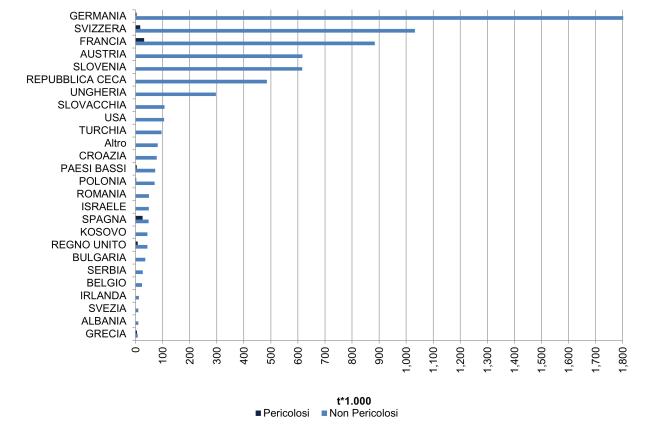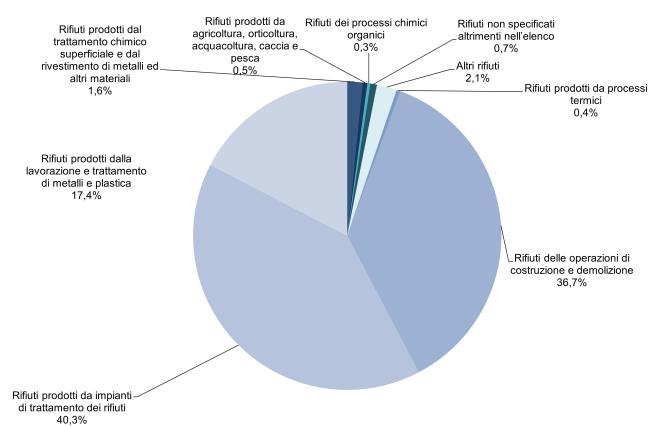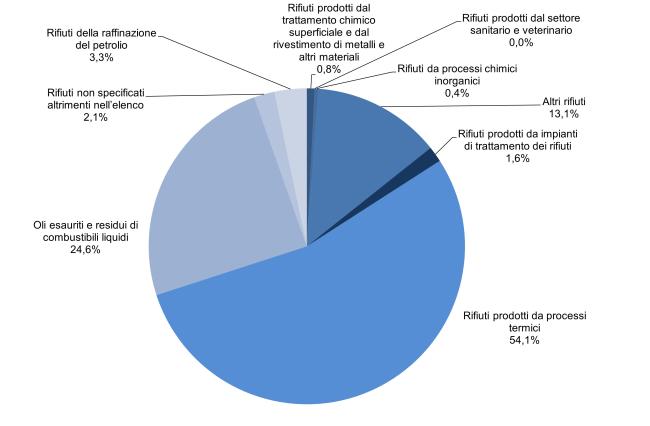Panel 1
Gabriella Aragona, Lucia Muto
The indicator measures the quantities of special waste that are imported for the purposes of a recovery in production activities. The special waste imported into Italy in 2023 (over 6.8 million tons) consists almost exclusively of non-hazardous waste (98.5%); The dangerous waste, in fact, is 101 thousand tons (1.5% of the total imported). The greater quantity comes from Germany, over 1.8 million tons (26.7% of the total imported), consisting almost entirely by non-hazardous waste (the dangerous waste is only 3,573 tons), purely metallic waste. Switzerland follows, with over 1 million tons (15.4% of the total), consisting mainly of earth and rock waste.
The indicator provides information on the types of waste that are imported into the national territory, specifying the country of origin and the destination region.
Analyze which types of waste are imported for the purposes of recovery in production activities.
• Basel Convention of 22/03/1989 on the control of cross-border movements of hazardous waste and their disposal and subsequent amendments;
• OCSE C decision (2001) 107 on the control of cross-border movements of waste intended for recovery;
• Regulation 1013/2006/EC and S. M. I. Governing the shipment of waste between community member states, also through third countries;
• Regulation 1418/2007/EC and S. M. I. Relating to the export of some waste intended for the recovery, to some countries to which the OECD decision does not apply.
There are no objectives set by the legislation.
Panel 2
ISPRA - Rapporto rifiuti speciali 2025
Data quality assessment
ISPRA (Higher Institute for Environmental Protection and Research)
ISPRA, MUD database, not accessible to the public
National, regional
2010-2023
Indicator assessment
The quantities of imported special waste are analyzed for single EER Code, by country of origin and by destination region.
Special waste imported into Italy in 2023, amounting to over 6.8 million tons, consisted almost entirely of non-hazardous waste (98.5%), while hazardous waste accounted for 101 thousand tons (1.5% of total imports).
Of the imported waste, 76.7% (around 5.2 million tons) was made up of metal waste, recovered within the production cycle of metallurgical industries—an encouraging sign, as it reduces the use of raw materials.
In 2023 the positive trend of past years is confirmed (+39.1% in 2010- 2023) (Table 1).



Special waste imported into Italy in 2023 amounted to over 6.8 million tons. The largest share came from Germany, over 1.8 million tons, consisting almost entirely of non-hazardous waste (hazardous waste accounted for only 3,573 tons), mainly of metallic nature (Table 2 and Figure 1).
Lombardy is the region importing the highest quantity of waste, about 3.5 million tons (50.6% of the total), mainly metallic waste, in line with its industrial specialization in sectors such as metallurgy and steelmaking (Table 3). It is followed by Friuli-Venezia Giulia and Veneto with 26.8% and 10.1% of the total, respectively; in these regions too, almost exclusively metallic waste is imported and reused in the production cycle.
Waste from construction and demolition activities accounts for 36.7% of total non-hazardous waste imports (about 2.5 million tons) (Figure 2). A further 40.3% of non-hazardous waste imports (equal to 2.7 million tons) is represented by “waste from waste treatment facilities,” with a prevalence, in quantitative terms, of “ferrous metals,” “iron and steel,” and “non-ferrous metals.” Additional confirmation of the significant import of ferrous scrap is the high share recorded for “waste from the processing and treatment of metals and plastics” (17.4%), predominantly metallic in nature.
With regard to hazardous special waste, “waste from thermal processes” constitutes the largest share imported, equal to 54.1% (Figure 3).